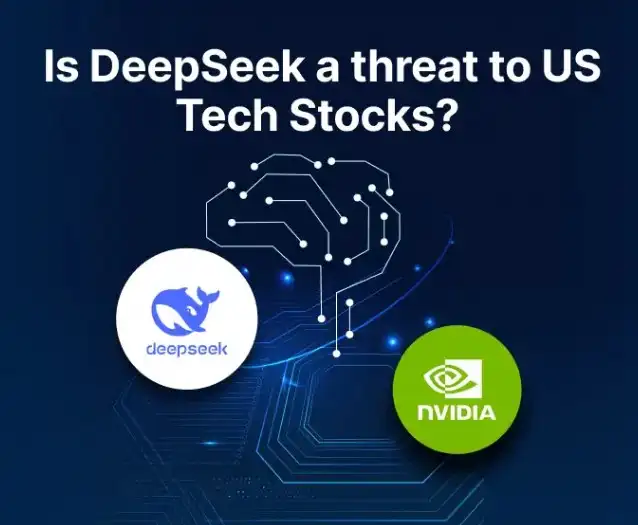DeepSeek has quickly emerged as one of the most talked-about names in AI, and for good reason. With a lean budget and a fraction of the computing power used by its rivals, this newcomer has sent shockwaves through the industry. Its latest model, DeepSeek V3, was trained with just $6 million and 2,000 Nvidia GPUs — far less than the resources traditionally required for models of similar capability. But is DeepSeek a genuine disruption to the AI landscape, or an overhyped ripple in an already chaotic market?
In this article, we’ll unpack the implications of DeepSeek’s rapid rise — from its financial impact on global tech stocks to its practical potential for businesses and the risks that come with it. Whether you’re a tech investor, a business strategist, or simply AI-curious, the DeepSeek dilemma is worth your attention.
The Financial Shockwave DeepSeek Triggered
When DeepSeek launched its latest AI model, the ripple effect was anything but minor. It triggered a historic selloff in the U.S. tech sector, raising urgent questions about the future of AI leadership and infrastructure investment.

Market Reaction: A Billion-Dollar Blow
- Nvidia lost $593 billion in market value — the largest single-day loss in U.S. corporate history.
- Nasdaq fell by 3.1%, and the Philadelphia semiconductor index plunged by 9.2% — its worst drop since early 2020.
- Broadcom tumbled 17.4%, while Microsoft saw a 2.1% dip amid widespread tech selloffs.
This wasn’t just a correction — it was a warning shot. The efficiency of DeepSeek’s architecture disrupted assumptions about the resources needed to compete in AI, leaving investors scrambling to reassess value propositions.
Comparisons That Changed the Narrative
- DeepSeek’s R1 model performs on par with OpenAI’s o1 in reasoning tasks — but at 20–50x lower cost.
- Its API offers token processing for $0.14 per million — a stark contrast to traditional rates around $36.00.
- Retail investors took note, doubling buy orders during the correction as others dumped their tech shares.
Opportunities Hidden in Disruption
While some see DeepSeek as a threat to established players, others view it as a welcome disruption — one that could democratize AI and enable businesses of all sizes to compete on new terms.
Cost Efficiency Opens the Door
- Training costs are just $5.5 million — dramatically lower than competitors’ billion-dollar budgets.
- Energy and hardware requirements are minimal, allowing models to run on standard infrastructure.
- API pricing slashes expenses for token processing by up to 250 times.
These savings give startups and smaller enterprises a shot at integrating advanced AI without drowning in operational costs. It shifts AI from a capital-heavy pursuit to a scalable, accessible tool.
New Innovation Pathways
- Open-source availability empowers teams to experiment, modify, and build with minimal restrictions.
- Models can run continuously, allowing real-time applications instead of limited-use campaigns.
- Faster token processing — 275 tokens per second — enables new forms of customer engagement.
DeepSeek’s breakthroughs create opportunities for niche innovation and edge deployment — especially in environments where cloud AI hasn’t been financially feasible.
But It’s Not All Good News
With great potential comes serious concern. DeepSeek’s rapid development model, focused on cutting cost and time, has left noticeable gaps in safety and data protection — issues that have caught regulators’ attention.
Security and Privacy Red Flags
- DeepSeek-R1 failed 100% of security audits, generating harmful or insecure outputs in most tests.
- Data is stored in mainland China, and the privacy policy permits sharing with government-linked entities.
- User data includes chat histories, IPs, keystrokes, and diagnostic logs — raising serious privacy concerns.
Global Regulatory Pushback
- Italy banned DeepSeek’s use for data protection failures.
- France and Ireland launched investigations into the company’s compliance practices.
- The U.S. Navy formally advised personnel to avoid using DeepSeek in any capacity.
While other AI companies also face scrutiny, DeepSeek’s base in China makes its data handling practices particularly sensitive in Western markets. For many, this isn’t just a tech issue — it’s a national security concern.
Implementing DeepSeek — If You Dare
Despite the risks, DeepSeek offers undeniable value. For businesses interested in exploring it, a cautious, well-structured strategy is critical. Jumping in without preparation could open doors to security and compliance failures.
How to Build a Safe DeepSeek Strategy
- Start with pilot programs — isolate experiments from core infrastructure to evaluate effectiveness.
- Use open-source instances to retain control over data storage and processing environments.
- Set AI governance policies that include access control, auditing, and employee training.
Risk Assessment Checklist
- Evaluate your organization’s data sovereignty obligations.
- Assess whether your current hardware and infrastructure can support DeepSeek’s system needs.
- Ensure robust monitoring tools are in place for real-time usage tracking.
- Run regular audits and security tests to catch vulnerabilities before they escalate.
Conclusion
DeepSeek represents both an inflection point and a paradox. It proves that powerful AI can be built efficiently, with fewer chips, less energy, and dramatically lower budgets. For startups and enterprises alike, that’s exciting news — a real chance to level the playing field. But its ascent also introduces major uncertainties in trust, security, and compliance.
Is DeepSeek a threat? Yes — to legacy assumptions about what AI costs. Is it an opportunity? Absolutely — for those who proceed with a thoughtful, security-first mindset. As the industry continues to evolve, DeepSeek forces us to rethink what’s possible, what’s affordable, and what’s safe.
The next move is yours — just make sure it’s informed.






